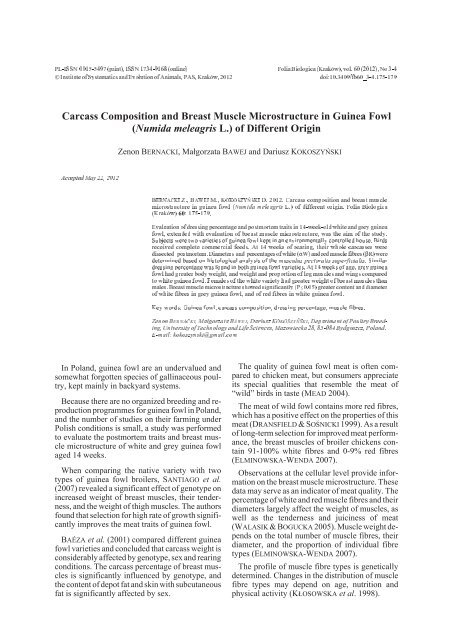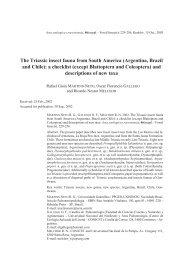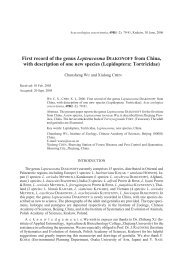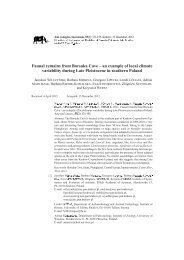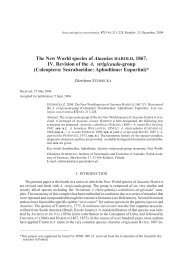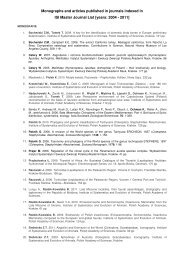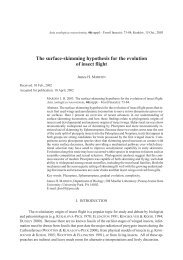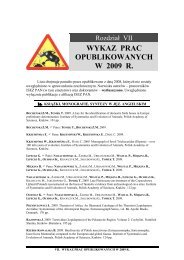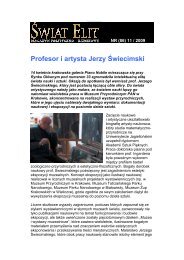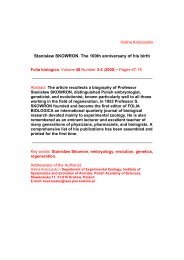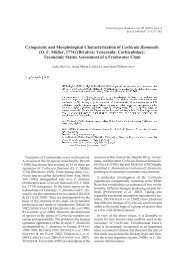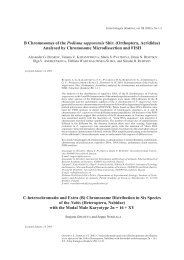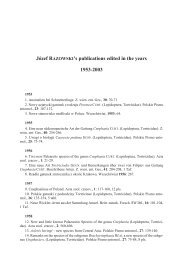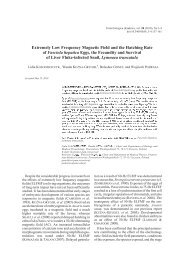Carcass composition and breast muscle microstructure in guinea fowl
Carcass composition and breast muscle microstructure in guinea fowl
Carcass composition and breast muscle microstructure in guinea fowl
You also want an ePaper? Increase the reach of your titles
YUMPU automatically turns print PDFs into web optimized ePapers that Google loves.
PL-ISSN 0015-5497(pr<strong>in</strong>t),ISSN1734-9168(onl<strong>in</strong>e)<br />
InstituteofSystematics<strong>and</strong>EvolutionofAnimals,PAS,Kraków,2012<br />
FoliaBiologica(Kraków),vol.60(2012),No3-4<br />
doi:10.3409/fb60_3-4.175-179<br />
<strong>Carcass</strong> Composition <strong>and</strong> Breast Muscle Microstructure <strong>in</strong> Gu<strong>in</strong>ea Fowl<br />
(Numida meleagris L.) of Different Orig<strong>in</strong><br />
AcceptedMay22,2012<br />
Zenon BERNACKI, Ma³gorzata BAWEJ <strong>and</strong> Dariusz KOKOSZYÑSKI<br />
BERNACKI Z., BAWEJ M., KOKOSZYÑSKI D. 2012. <strong>Carcass</strong> <strong>composition</strong> <strong>and</strong> <strong>breast</strong> <strong>muscle</strong><br />
<strong>microstructure</strong> <strong>in</strong> gu<strong>in</strong>ea <strong>fowl</strong> (Numida meleagris L.) of different orig<strong>in</strong>. Folia Biologica<br />
(Kraków) 60: 175-179.<br />
Evaluationofdress<strong>in</strong>gpercentage<strong>and</strong>postmortemtraits<strong>in</strong>14-week-oldwhite<strong>and</strong>greygu<strong>in</strong>ea<br />
<strong>fowl</strong>, extended with evaluation of <strong>breast</strong> <strong>muscle</strong> <strong>microstructure</strong>, was the aim of the study.<br />
Subjectsweretwovarietiesofgu<strong>in</strong>ea<strong>fowl</strong>kept<strong>in</strong>anenvironmentallycontrolledhouse.Birds<br />
received complete commercial feeds. At 14 weeks of rear<strong>in</strong>g, their whole carcasses were<br />
dissected postmortem.Diameters <strong>and</strong> percentagesofwhite(W)<strong>and</strong>red<strong>muscle</strong>fibres(R)were<br />
determ<strong>in</strong>ed based on histological analysis of the musculus pectoralis superficialis. Similar<br />
dress<strong>in</strong>gpercentagewasfound<strong>in</strong>bothgu<strong>in</strong>ea<strong>fowl</strong>varieties.At14weeksofage,greygu<strong>in</strong>ea<br />
<strong>fowl</strong>hadgreaterbodyweight,<strong>and</strong>weight<strong>and</strong>proportionofleg<strong>muscle</strong>s<strong>and</strong>w<strong>in</strong>gscompared<br />
towhitegu<strong>in</strong>ea<strong>fowl</strong>.Femalesofthewhitevarietyhadgreaterweightof<strong>breast</strong><strong>muscle</strong>sthan<br />
males.Breast<strong>muscle</strong><strong>microstructure</strong>showedsignificantly(P0.05)greatercontent<strong>and</strong>diameter<br />
of white fibres <strong>in</strong> grey gu<strong>in</strong>ea <strong>fowl</strong>, <strong>and</strong> of red fibres <strong>in</strong> white gu<strong>in</strong>ea <strong>fowl</strong>.<br />
Key words: Gu<strong>in</strong>ea <strong>fowl</strong>, carcass <strong>composition</strong>, dress<strong>in</strong>g percentage, <strong>muscle</strong> fibres.<br />
ZenonBERNACKI,Ma³gorzataBAWEJ,DariuszKOKOSZYÑSKI,DepartmentofPoultryBreed<strong>in</strong>g,UniversityofTechnology<strong>and</strong>LifeSciences,Mazowiecka28,85-084Bydgoszcz,Pol<strong>and</strong>.<br />
E-mail: kokoszynski@gmail.com<br />
In Pol<strong>and</strong>, gu<strong>in</strong>ea <strong>fowl</strong> are an undervalued <strong>and</strong><br />
somewhat forgotten species of gall<strong>in</strong>aceous poultry,<br />
kept ma<strong>in</strong>ly <strong>in</strong> backyard systems.<br />
Because there are no organized breed<strong>in</strong>g <strong>and</strong> reproduction<br />
programmes for gu<strong>in</strong>ea <strong>fowl</strong> <strong>in</strong> Pol<strong>and</strong>,<br />
<strong>and</strong> the number of studies on their farm<strong>in</strong>g under<br />
Polish conditions is small, a study was performed<br />
to evaluate the postmortem traits <strong>and</strong> <strong>breast</strong> <strong>muscle</strong><br />
<strong>microstructure</strong> of white <strong>and</strong> grey gu<strong>in</strong>ea <strong>fowl</strong><br />
aged 14 weeks.<br />
When compar<strong>in</strong>g the native variety with two<br />
types of gu<strong>in</strong>ea <strong>fowl</strong> broilers, SANTIAGO et al.<br />
(2007) revealed a significant effect of genotype on<br />
<strong>in</strong>creased weight of <strong>breast</strong> <strong>muscle</strong>s, their tenderness,<br />
<strong>and</strong> the weight of thigh <strong>muscle</strong>s. The authors<br />
found that selection for high rate of growth significantly<br />
improves the meat traits of gu<strong>in</strong>ea <strong>fowl</strong>.<br />
BAÉZA et al. (2001) compared different gu<strong>in</strong>ea<br />
<strong>fowl</strong> varieties <strong>and</strong> concluded that carcass weight is<br />
considerably affected by genotype, sex <strong>and</strong> rear<strong>in</strong>g<br />
conditions. The carcass percentage of <strong>breast</strong> <strong>muscle</strong>s<br />
is significantly <strong>in</strong>fluenced by genotype, <strong>and</strong><br />
the content of depot fat <strong>and</strong> sk<strong>in</strong> with subcutaneous<br />
fat is significantly affected by sex.<br />
The quality of gu<strong>in</strong>ea <strong>fowl</strong> meat is often compared<br />
to chicken meat, but consumers appreciate<br />
its special qualities that resemble the meat of<br />
“wild” birds <strong>in</strong> taste (MEAD 2004).<br />
The meat of wild <strong>fowl</strong> conta<strong>in</strong>s more red fibres,<br />
which has a positive effect on the properties of this<br />
meat (DRANSFIELD & SOŒNICKI 1999). As a result<br />
of long-term selection for improved meat performance,<br />
the <strong>breast</strong> <strong>muscle</strong>s of broiler chickens conta<strong>in</strong><br />
91-100% white fibres <strong>and</strong> 0-9% red fibres<br />
(ELMINOWSKA-WENDA 2007).<br />
Observations at the cellular level provide <strong>in</strong>formation<br />
on the <strong>breast</strong> <strong>muscle</strong> <strong>microstructure</strong>. These<br />
data may serve as an <strong>in</strong>dicator of meat quality. The<br />
percentage of white <strong>and</strong> red <strong>muscle</strong> fibres <strong>and</strong> their<br />
diameters largely affect the weight of <strong>muscle</strong>s, as<br />
well as the tenderness <strong>and</strong> juic<strong>in</strong>ess of meat<br />
(WALASIK & BOGUCKA 2005). Muscle weight depends<br />
on the total number of <strong>muscle</strong> fibres, their<br />
diameter, <strong>and</strong> the proportion of <strong>in</strong>dividual fibre<br />
types (ELMINOWSKA-WENDA 2007).<br />
The profile of <strong>muscle</strong> fibre types is genetically<br />
determ<strong>in</strong>ed. Changes <strong>in</strong> the distribution of <strong>muscle</strong><br />
fibre types may depend on age, nutrition <strong>and</strong><br />
physical activity (K£OSOWSKA et al. 1998).
176<br />
Z. BERNACKI et al.<br />
White Italian geese selected for meat production<br />
have more white fibres <strong>in</strong> <strong>breast</strong> <strong>muscle</strong> compared<br />
to those selected for egg production (K£OSOWSKA<br />
et al. 1993). Chickens with a rapid growth rate are<br />
characterized by greater fibre diameters than those<br />
from slow-grow<strong>in</strong>g l<strong>in</strong>es. The <strong>muscle</strong>s of <strong>in</strong>tensively<br />
farmed ducks conta<strong>in</strong> more white fibres,<br />
<strong>and</strong> those of extensively farmed ducks have more<br />
red fibres (DRANSFIELD & SOŒNICKI 1999).<br />
The evaluation <strong>and</strong> comparison of meat traits <strong>in</strong><br />
gu<strong>in</strong>ea <strong>fowl</strong> may arouse the <strong>in</strong>terest of potential<br />
producers of this avian species. Gu<strong>in</strong>ea <strong>fowl</strong> meat<br />
has the advantage of unique taste, which also <strong>in</strong><br />
Pol<strong>and</strong> could be an attractive proposition for consumers<br />
who look for healthy <strong>and</strong> tasty products.<br />
The aim of the study was to compare white <strong>and</strong><br />
grey gu<strong>in</strong>ea <strong>fowl</strong> for body weight, carcass weight,<br />
dress<strong>in</strong>g percentage, carcass <strong>composition</strong>, <strong>and</strong> <strong>microstructure</strong><br />
of the musculus pectoralis superficialis.<br />
Material <strong>and</strong> Methods<br />
The study was carried out accord<strong>in</strong>g to the guidel<strong>in</strong>es<br />
of the Ethical Committee <strong>in</strong> Bydgoszcz (No.<br />
8/2004).<br />
The study was carried out at the experimental<br />
poultry farm <strong>in</strong> Wierzchuc<strong>in</strong>ek, operat<strong>in</strong>g as part<br />
of the Agricultural Experimental Station M<strong>in</strong>ikowo,<br />
which belongs to the University of Technology <strong>and</strong><br />
Life Sciences <strong>in</strong> Bydgoszcz. White <strong>and</strong> grey gu<strong>in</strong>ea<br />
<strong>fowl</strong> <strong>and</strong> their meat served as experimental material.<br />
34 birds of each variety were reared to 14 weeks<br />
of age. Gu<strong>in</strong>ea <strong>fowl</strong> were kept <strong>in</strong> an environmentally<br />
controlled house <strong>and</strong> received complete diets.<br />
Birds were fed a diet conta<strong>in</strong><strong>in</strong>g 19.5% crude prote<strong>in</strong><br />
<strong>and</strong> 12.4 MJ (2950 kcal) ME to 8 weeks of age,<br />
<strong>and</strong> a diet conta<strong>in</strong><strong>in</strong>g 17.5% prote<strong>in</strong> <strong>and</strong> 12.6 MJ<br />
(3000 kcal) ME from 9 to 14 weeks of age.<br />
At the end of 14 weeks of rear<strong>in</strong>g, gu<strong>in</strong>ea <strong>fowl</strong><br />
were slaughtered <strong>and</strong> their whole carcasses were<br />
dissected us<strong>in</strong>g the method described by ZIO£ECKI<br />
<strong>and</strong> DORUCHOWSKI (1989). Ten male <strong>and</strong> 10 female<br />
white <strong>and</strong> grey gu<strong>in</strong>ea <strong>fowl</strong> with close to average<br />
body weight for a given variety were selected for<br />
slaughter. After pluck<strong>in</strong>g, evisceration <strong>and</strong> 24-hour<br />
chill<strong>in</strong>g, their carcasses were dissected <strong>in</strong>to neck<br />
without sk<strong>in</strong>, <strong>breast</strong> <strong>muscle</strong>s, leg <strong>muscle</strong>s, sk<strong>in</strong> with<br />
subcutaneous fat from the whole carcass, abdom<strong>in</strong>al<br />
fat, w<strong>in</strong>gs, <strong>and</strong> the rema<strong>in</strong>ders of the carcass.<br />
Individual carcass components were weighed <strong>and</strong><br />
their percentage <strong>in</strong> the weight of eviscerated carcass<br />
with neck was calculated. Immediately after<br />
slaughter, sections of the musculus pectoralis superficialis<br />
were taken for histological exam<strong>in</strong>ation<br />
from 10 birds of each colour variety <strong>and</strong> frozen <strong>in</strong><br />
liquid nitrogen (-196 o C). The <strong>muscle</strong> slices were<br />
cut <strong>in</strong>to 10 m sections on a Leica cryostat at<br />
-25 o C. The cuts were subjected to NADH-TR histochemical<br />
reaction accord<strong>in</strong>g to DUBOWITZ et al.<br />
(1973). This sta<strong>in</strong><strong>in</strong>g dist<strong>in</strong>guishes two types of<br />
<strong>muscle</strong> fibres. White fibres with low NADH-TR<br />
activity sta<strong>in</strong> light blue, <strong>and</strong> red fibres with high<br />
NADH-TR activity sta<strong>in</strong> dark blue. Muscle fibre<br />
diameters were measured us<strong>in</strong>g a lanameter (made<br />
<strong>in</strong> Polskie Zak³ady Optyczne, model MP 3/1005),<br />
<strong>and</strong> <strong>muscle</strong> fibre percentages were calculated with<br />
the use of a Nikon microscope.<br />
The percentages of white <strong>and</strong> red fibres were determ<strong>in</strong>ed<br />
by calculat<strong>in</strong>g the number of fibres <strong>in</strong> a<br />
primary <strong>muscle</strong> bundle (10 bundles per bird). The<br />
analysis was performed at the Departments of Animal<br />
Biotechnology (Division of Animal Histology)<br />
<strong>and</strong> Poultry Breed<strong>in</strong>g of the University of<br />
Technology <strong>and</strong> Life Sciences <strong>in</strong> Bydgoszcz.<br />
The numerical data were analysed statistically <strong>in</strong><br />
an Excel spreadsheet. Means (x) <strong>and</strong> st<strong>and</strong>ard errors<br />
(SE) were calculated for the analysed traits. The<br />
significance of differences <strong>in</strong> the analysed traits<br />
between the gu<strong>in</strong>ea <strong>fowl</strong> varieties was measured<br />
us<strong>in</strong>g analysis of variance <strong>and</strong> Student’s t-test.<br />
Results<br />
Compared to grey gu<strong>in</strong>ea <strong>fowl</strong>, white gu<strong>in</strong>ea<br />
<strong>fowl</strong> consumed less feed to 14 weeks of age, but<br />
were characterized by poorer feed conversion rate<br />
per kg weight ga<strong>in</strong> to 8 weeks of age <strong>and</strong> throughout<br />
the rear<strong>in</strong>g period (Table 1).<br />
Feed consumption <strong>and</strong> conversion by gu<strong>in</strong>ea <strong>fowl</strong> dur<strong>in</strong>g the rear<strong>in</strong>g period<br />
Table 1<br />
Age <strong>in</strong> weeks<br />
Feed consumption per bird (g)<br />
Feed conversion (g/kg ga<strong>in</strong>)<br />
variety<br />
white grey white grey<br />
1-8 2173 2250 3449 3243<br />
9-14 3900 3994 6870 6916<br />
1-14 6073 6244 5070 4912
<strong>Carcass</strong> Quality of Gu<strong>in</strong>ea Fowl 177<br />
The grey gu<strong>in</strong>ea <strong>fowl</strong> whose postmortem traits<br />
were analysed at 14 weeks had significantly<br />
(P0.05) higher body weight, w<strong>in</strong>gs weight <strong>and</strong><br />
weight of leg <strong>muscle</strong>s compared to white gu<strong>in</strong>ea<br />
<strong>fowl</strong>. This was reflected <strong>in</strong> the significantly<br />
(P0.05) higher percentage of w<strong>in</strong>gs <strong>and</strong> leg <strong>muscle</strong>s<br />
<strong>in</strong> the carcasses of grey compared to white<br />
gu<strong>in</strong>ea <strong>fowl</strong>, despite the similar dress<strong>in</strong>g percentage<br />
<strong>in</strong> both varieties (Table 2).<br />
Females of the white variety had significantly<br />
greater weight of <strong>breast</strong> <strong>muscle</strong>s compared to<br />
males. This was the only statistically significant<br />
difference <strong>in</strong> postmortem traits between males <strong>and</strong><br />
females with<strong>in</strong> the analysed colour varieties.<br />
Table 3 lists the diameters <strong>and</strong> percentages of<br />
white (áW) <strong>and</strong> red fibres (âR) <strong>in</strong> the <strong>breast</strong> <strong>muscle</strong><br />
of both colour varieties of gu<strong>in</strong>ea <strong>fowl</strong> aged 14<br />
weeks. Grey gu<strong>in</strong>ea <strong>fowl</strong> had a significantly<br />
(P0.05) greater proportion of white fibres compared<br />
to white gu<strong>in</strong>ea <strong>fowl</strong>. The proportion of red<br />
fibres <strong>in</strong> the <strong>breast</strong> <strong>muscle</strong> of grey gu<strong>in</strong>ea <strong>fowl</strong> was<br />
significantly lower compared to that <strong>in</strong> white<br />
gu<strong>in</strong>ea <strong>fowl</strong>.<br />
The diameter of white fibres <strong>in</strong> the musuclus<br />
pectoralis superficialis was significantly (P0.05)<br />
higher <strong>in</strong> grey compared to white gu<strong>in</strong>ea <strong>fowl</strong>. Red<br />
fibres had a significantly greater diameter <strong>in</strong> the<br />
<strong>breast</strong> <strong>muscle</strong> of white compared to grey gu<strong>in</strong>ea<br />
Body weight <strong>and</strong> carcass <strong>composition</strong> <strong>in</strong> 14-week-old white <strong>and</strong> grey gu<strong>in</strong>ea <strong>fowl</strong><br />
Table 2<br />
Trait<br />
Variety<br />
white<br />
grey<br />
total males females total males females<br />
Body<br />
Dress<strong>in</strong>g percentage (%)<br />
<strong>Carcass</strong><br />
Neck<br />
W<strong>in</strong>gs<br />
Breast <strong>muscle</strong>s<br />
Leg <strong>muscle</strong>s<br />
Sk<strong>in</strong> with fat<br />
Rema<strong>in</strong>ders<br />
x<br />
SE<br />
x<br />
SE<br />
x<br />
SE<br />
x<br />
SE<br />
x<br />
SE<br />
x<br />
SE<br />
x<br />
SE<br />
x<br />
SE<br />
x<br />
SE<br />
1270 a<br />
8.40<br />
70.01<br />
0.50<br />
889.0<br />
0.90<br />
44.0<br />
0.56<br />
115.0 a<br />
1.27<br />
246.0*<br />
4.36<br />
187.0 a<br />
5.85<br />
61.0<br />
3.10<br />
236.0<br />
4.03<br />
Weight (g)<br />
1268<br />
6.80<br />
69.12<br />
0.46<br />
877.0<br />
0.90<br />
44.0<br />
0.40<br />
115.0<br />
1.53<br />
238.0<br />
3.99<br />
188.0<br />
5.35<br />
62.0<br />
3.39<br />
230.0<br />
4.22<br />
1272<br />
7.40<br />
70.90<br />
0.26<br />
902.0<br />
0.60<br />
43.0<br />
0.55<br />
115.0<br />
0.85<br />
255.0<br />
1.98<br />
185.0<br />
4.88<br />
60.0<br />
2.23<br />
244.0<br />
2.12<br />
1302 b<br />
10.30<br />
69.46<br />
0.31<br />
904.0<br />
0.90<br />
43.0<br />
1.49<br />
128.0 b<br />
3.16<br />
249.0<br />
5.35<br />
211.0 b<br />
4.47<br />
57.0<br />
4.65<br />
216.0<br />
12.3<br />
1318<br />
10.40<br />
69.36<br />
0.31<br />
914.0<br />
1.00<br />
40.0<br />
1.63<br />
126.0<br />
4.18<br />
252.0<br />
7.49<br />
212.0<br />
5.23<br />
51.0<br />
5.10<br />
233.0<br />
13.4<br />
1286<br />
5.50<br />
69.55<br />
0.32<br />
894.0<br />
0.60<br />
46.0<br />
0.52<br />
129.0<br />
1.50<br />
247.0<br />
1.82<br />
210.0<br />
2.91<br />
62.0<br />
2.72<br />
200.0<br />
5.06<br />
Proportion <strong>in</strong> carcass (%)<br />
Neck<br />
W<strong>in</strong>gs<br />
Breast <strong>muscle</strong>s<br />
Leg <strong>muscle</strong>s<br />
Sk<strong>in</strong> with fat<br />
Rema<strong>in</strong>ders<br />
x<br />
SE<br />
x<br />
SE<br />
x<br />
SE<br />
x<br />
SE<br />
x<br />
SE<br />
x<br />
SE<br />
4.94*<br />
0.07<br />
12.93 a<br />
0.22<br />
27.67<br />
0.40<br />
21.03 a<br />
0.58<br />
6.86<br />
0.36<br />
26.57 a<br />
0.30<br />
5.02<br />
0.06<br />
13.11<br />
0.28<br />
27.13<br />
0.32<br />
21.44<br />
0.50<br />
7.07<br />
0.38<br />
26.23<br />
0.26<br />
4.76<br />
0.05<br />
12.75<br />
0.09<br />
28.27<br />
0.50<br />
20.51<br />
0.54<br />
6.67<br />
0.26<br />
27.04<br />
0.33<br />
4.76<br />
0.19<br />
14.16 b<br />
0.31<br />
27.54<br />
0.51<br />
23.34 b<br />
0.56<br />
6.31<br />
0.48<br />
23.89 b<br />
1.36<br />
4.44<br />
0.20<br />
13.80<br />
0.30<br />
27.57<br />
0.60<br />
23.19<br />
0.62<br />
5.58<br />
0.51<br />
25.42<br />
1.64<br />
5.14<br />
0.09<br />
14.43<br />
0.10<br />
27.63<br />
0.10<br />
23.48<br />
0.45<br />
6.94<br />
0.37<br />
22.38<br />
0.45<br />
a, b – values <strong>in</strong> the rows with different letters differ significantly between varieties (P0.05).<br />
* statistically significant differences between males <strong>and</strong> females with<strong>in</strong> variety (P0.05).
178<br />
Z. BERNACKI et al.<br />
Table 3<br />
Percentage <strong>and</strong> diameter of white (áW) <strong>and</strong> red (âR) fibres <strong>in</strong> bundles of the musculus pectoralis<br />
superficialis <strong>in</strong> 14-week-old white <strong>and</strong> grey gu<strong>in</strong>ea <strong>fowl</strong><br />
Gu<strong>in</strong>ea <strong>fowl</strong><br />
variety<br />
white<br />
grey<br />
x<br />
SE<br />
x<br />
SE<br />
Content (%)<br />
Diameter (m)<br />
áW fibres âR fibres áW fibres âR fibres<br />
67.09 a<br />
32.91 a<br />
52.94 a<br />
39.45 a<br />
0.32<br />
0.32<br />
0.24<br />
0.68<br />
69.08 b<br />
0.18<br />
30.91 b<br />
0.18<br />
53.26 b<br />
0.40<br />
36.92 b<br />
0.31<br />
a, b – values <strong>in</strong> the columns with different letters differ significantly between varieties (P0.05)<br />
<strong>fowl</strong>. The st<strong>and</strong>ard errors for both fibre types are<br />
low, which shows that the diameters <strong>and</strong> percentages<br />
of red <strong>and</strong> white fibres <strong>in</strong> the musculus pectoralis<br />
superficialis of white <strong>and</strong> grey gu<strong>in</strong>ea <strong>fowl</strong><br />
are quite uniform.<br />
Discussion<br />
The analysed birds were characterized by poorer<br />
feed conversion compared to young gu<strong>in</strong>ea <strong>fowl</strong> <strong>in</strong>vestigated<br />
by FR¥TCZAK et al. (2002) <strong>and</strong> TUFA-<br />
RELLI et al. (2007). When compar<strong>in</strong>g several variants<br />
of feed formulas used <strong>in</strong> rear<strong>in</strong>g gu<strong>in</strong>ea <strong>fowl</strong><br />
to 12 weeks of age, FR¥TCZAK et al. (2002) found<br />
FCR values to range from 3.5 to 3.9 kg/kg. Gu<strong>in</strong>ea<br />
<strong>fowl</strong> studied by TUFARELLI et al. (2007) from 4 to<br />
13 weeks of rear<strong>in</strong>g consumed from 3.74 to 3.86<br />
kg feed per kg ga<strong>in</strong>. Similar feed conversion (3.7<br />
kg feed/kg ga<strong>in</strong>) was reported for gu<strong>in</strong>ea <strong>fowl</strong> to 15<br />
weeks of age by DRABO (1992).<br />
At 14 weeks of age, the gu<strong>in</strong>ea <strong>fowl</strong> varieties<br />
achieved higher body weight <strong>and</strong> dress<strong>in</strong>g percentage<br />
compared to 16-week-old gu<strong>in</strong>ea <strong>fowl</strong><br />
(1048 g, 66.0%) <strong>in</strong>vestigated by GILEWSKI et al.<br />
(1990). The same authors also found lower content<br />
of <strong>breast</strong> <strong>muscle</strong>s <strong>and</strong> leg <strong>muscle</strong>s <strong>in</strong> the carcasses<br />
of 16-week-old gu<strong>in</strong>ea <strong>fowl</strong> compared to 14-week-old<br />
birds evaluated <strong>in</strong> our study.<br />
PUDYSZAK et al. (2003, 2005) analysed dress<strong>in</strong>g<br />
percentage <strong>in</strong> gu<strong>in</strong>ea <strong>fowl</strong> aged 14, 16 <strong>and</strong> 18 weeks<br />
<strong>and</strong> found higher dress<strong>in</strong>g percentage at 14 weeks<br />
(73.61%) but with lower body weight (1181 g)<br />
than <strong>in</strong> our study. Based on the dress<strong>in</strong>g percentage<br />
<strong>and</strong> chemical <strong>composition</strong> of <strong>muscle</strong>s at 14, 16<br />
<strong>and</strong> 18 weeks of rear<strong>in</strong>g, PUDYSZAK et al. (2003)<br />
recommend that gu<strong>in</strong>ea <strong>fowl</strong> broilers should be<br />
raised to 14 weeks of age.<br />
The content of <strong>breast</strong> <strong>muscle</strong>s <strong>in</strong> the carcasses of<br />
14-week-old gu<strong>in</strong>ea <strong>fowl</strong> was 9.8% higher, <strong>and</strong><br />
that of leg <strong>muscle</strong>s 3.07% higher <strong>in</strong> white gu<strong>in</strong>ea<br />
<strong>fowl</strong> <strong>and</strong> 5.5% higher <strong>in</strong> grey gu<strong>in</strong>ea <strong>fowl</strong> compared<br />
to the values reported by PUDYSZAK et al.<br />
(2005). The high percentage of <strong>breast</strong> <strong>and</strong> thigh<br />
<strong>muscle</strong>s <strong>in</strong> carcasses makes gu<strong>in</strong>ea <strong>fowl</strong> suitable<br />
for use as broilers.<br />
Other authors (FUENTES et al. 1998) found a<br />
lack of sexual dimorphism <strong>in</strong> dress<strong>in</strong>g percentage<br />
but a higher fat content of <strong>muscle</strong>s <strong>in</strong> females compared<br />
to males aged 12 weeks. In another study<br />
(KOKOSZYÑSKI et al. 2011) males compared to females<br />
had lower body weight, carcass weight,<br />
dress<strong>in</strong>g percentage, content of <strong>breast</strong> <strong>muscle</strong>s <strong>and</strong><br />
abdom<strong>in</strong>al fat, <strong>and</strong> a higher proportion of leg <strong>muscle</strong>s<br />
at 13 <strong>and</strong> 16 weeks of age.<br />
Just as <strong>in</strong> hens, white fibres predom<strong>in</strong>ate <strong>in</strong> the<br />
<strong>breast</strong> <strong>muscle</strong>s of gu<strong>in</strong>ea <strong>fowl</strong> of both colour varieties.<br />
ELMINOWSKA-WENDA (2007) reported that<br />
for hens, this content ranges from 93.23 to 100%<br />
for white fibres <strong>and</strong> from 0 to 9.02% for red fibres<br />
depend<strong>in</strong>g on the flock. In the study cited above,<br />
the diameters ranged from 26.95 to 49.11 m for<br />
white fibres <strong>and</strong> from 23.03 to 36.49m for red fibres,<br />
<strong>and</strong> were lower than <strong>in</strong> the musculus pectoralis<br />
superficialis of gu<strong>in</strong>ea <strong>fowl</strong> analysed <strong>in</strong> our study.<br />
The mean white fibre diameters of <strong>breast</strong> <strong>muscle</strong><br />
from white (53.26 m) <strong>and</strong> grey gu<strong>in</strong>ea <strong>fowl</strong><br />
(52.94m) were similar to the white fibre diameter<br />
of <strong>breast</strong> <strong>muscle</strong> from WD-3 geese (52.86m).<br />
However, the diameter of red fibres was smaller <strong>in</strong><br />
the geese than <strong>in</strong> the gu<strong>in</strong>ea <strong>fowl</strong> <strong>and</strong> ranged from<br />
25.19 to 29.15m. The red fibre content of <strong>breast</strong><br />
<strong>muscle</strong> was greater <strong>in</strong> the geese than <strong>in</strong> the gu<strong>in</strong>ea<br />
<strong>fowl</strong> <strong>and</strong> ranged, depend<strong>in</strong>g on the l<strong>in</strong>e, from 75.8<br />
to 76.3%, <strong>and</strong> from 23.7 to 24.2% for white fibres<br />
(K£OSOWSKA et al. 1998). In 7-week-old ducks<br />
from P33 <strong>and</strong> K2 conservation flocks, the proportion<br />
of white fibres <strong>in</strong> <strong>breast</strong> <strong>muscle</strong> ranges from 27<br />
to 27.6%, <strong>and</strong> that of red fibres from 72.4 to 73%,<br />
with the diameters rang<strong>in</strong>g from 24.8 to 29m for<br />
white fibres <strong>and</strong> from 15.4 to 16m for red fibres<br />
(WITKIEWICZ 1999).
<strong>Carcass</strong> Quality of Gu<strong>in</strong>ea Fowl 179<br />
In terms of <strong>breast</strong> <strong>muscle</strong> <strong>microstructure</strong>, gu<strong>in</strong>ea<br />
<strong>fowl</strong> differ from other poultry species. As regards<br />
the predom<strong>in</strong>ance of white fibres they are similar<br />
to gall<strong>in</strong>aceous poultry, while the diameter of<br />
white fibres <strong>in</strong> this poultry species is similar to that<br />
<strong>in</strong> geese.<br />
In an earlier study, K£OSOWSKA et al. (1998)<br />
compared <strong>breast</strong> <strong>muscle</strong> <strong>microstructure</strong> <strong>in</strong> White<br />
Italian geese of l<strong>in</strong>e WD1 selected for egg production,<br />
<strong>in</strong> White Italian geese of l<strong>in</strong>e WD3 selected<br />
for meat production, <strong>and</strong> <strong>in</strong> L<strong>and</strong>es geese. They<br />
concluded that the greater body weight, diameter<br />
<strong>and</strong> percentage of white fibres <strong>in</strong> the White Italian<br />
geese is evidence that they grow more rapidly than<br />
the L<strong>and</strong>es geese. HEJNOWSKA et al. (1999) studied<br />
two groups of quail <strong>and</strong> found an <strong>in</strong>crease <strong>in</strong> the<br />
proportion of white fibres <strong>and</strong> greater diameters of<br />
red fibres <strong>in</strong> the <strong>breast</strong> <strong>muscle</strong> of the birds selected<br />
for meat production compared to general-purpose<br />
birds<br />
In summary, grey gu<strong>in</strong>ea <strong>fowl</strong> slaughtered at 14<br />
weeks of age had significantly greater preslaughter<br />
weight <strong>and</strong> their carcasses were characterized<br />
by significantly greater weight <strong>and</strong> proportion of<br />
leg <strong>muscle</strong>s <strong>and</strong> w<strong>in</strong>gs compared to white gu<strong>in</strong>ea<br />
<strong>fowl</strong>. Females of the white variety had significantly<br />
heavier <strong>breast</strong> <strong>muscle</strong>s compared to males.<br />
The proportion of eviscerated carcass with neck <strong>in</strong><br />
the preslaughter weight (dress<strong>in</strong>g percentage) of<br />
14-week-old gu<strong>in</strong>ea <strong>fowl</strong> of both varieties was<br />
similar <strong>and</strong> exceeded 69%. The significantly<br />
greater proportion <strong>and</strong> diameter of white fibres <strong>in</strong><br />
the musculus pectoralis superficialis of grey<br />
gu<strong>in</strong>ea <strong>fowl</strong>, along with the greater body weight of<br />
birds of this variety may be <strong>in</strong>dicative of their superior<br />
meat<strong>in</strong>ess compared to white gu<strong>in</strong>ea <strong>fowl</strong>.<br />
References<br />
BAÉZA E., JUIN H., REBOURS G., CONSTANTIN P., MARCHE<br />
G., LETERRIER C. 2001. Effect of genotype, sex <strong>and</strong> rear<strong>in</strong>g<br />
temperature on carcase <strong>and</strong> meat quality of gu<strong>in</strong>ea <strong>fowl</strong>. Br.<br />
Poult. Sci. 42: 470-476.<br />
DRABO A. 1992. Suivi technico-économoque d’une b<strong>and</strong>e de<br />
p<strong>in</strong>tades de chair à l’unité avicole de Bobo-Dioulasso. Rapport<br />
de f<strong>in</strong> de cycle. ENESA. Ouagadougou, Burk<strong>in</strong>a Faso.<br />
DRANSFIELD E., SOŒNICKI A. 1999. Relationship between<br />
<strong>muscle</strong> growth <strong>and</strong> poultry meat quality. Poult. Sci. 78:<br />
743-746.<br />
DUBOWITZ W., BROOKE M., NEVILLE H. E. 1973. Muscle<br />
Biopsy: A Modern approach., W. B. Saunders Company<br />
LTD London, Philadelphia, Toronto.<br />
ELMINOWSKA-WENDA G. 2007. Structure of skeletal <strong>muscle</strong>s<br />
<strong>in</strong> leghorn type chicken from conservative <strong>and</strong> parent flocks.<br />
Folia Biol. (Kraków) 55: 147-152.<br />
FUENTES M., ZAPATA J., ESPINDOLA B., FREITAS R., SAN-<br />
TOS M., SOUSA M. 1998. Sodium bicarbonate supplementation<br />
<strong>in</strong> diets for gu<strong>in</strong>ea <strong>fowl</strong> raised at high environmental<br />
temperatures. Poult. Sci. 77: 714-717.<br />
FR¥TCZAK M., RUTKOWSKI A., JÓZEFIAK D. 2002. Comparison<br />
of several diet formulas used <strong>in</strong> rear<strong>in</strong>g gu<strong>in</strong>ea <strong>fowl</strong>.<br />
Rocz. Nauk. Zoot., suppl. 16: 205-210. (In Polish with English<br />
summary).<br />
GILEWSKI R., STEFANIAK H., ZIÊBA G. 1990. Evaluation of<br />
meat performance <strong>in</strong> gu<strong>in</strong>ea <strong>fowl</strong> from native orig<strong>in</strong>. Rocz.<br />
Nauk. Zoot. 17: 17-23. (In Polish with English summary).<br />
HEJNOWSKA M., PUDYSZAK K., LUTHER R. 1999. Effect of<br />
orig<strong>in</strong> on <strong>microstructure</strong> of m. pectoralis superficialis <strong>and</strong><br />
certa<strong>in</strong> performance traits of Japanese quails. Zesz. Nauk.<br />
Prz. Hod. 45: 83-90. (In Polish with English summary).<br />
K£OSOWSKA D., ROSIÑSKI A., ELMINOWSKA-WENDA G.<br />
1993. Microstructural characteristics of the pectoralis <strong>muscle</strong><br />
of white Italian geese. In: Proceed<strong>in</strong>gs of the XI European<br />
Symposium on the Quality of Poultry Meat, vol 1.<br />
Tours, France, pp. 144-148.<br />
K£OSOWSKA D., ELMINOWSKA-WENDA G., LUTER R., ROSI-<br />
ÑSKI A., BAÉZA E., GUY G., SALICHON M. R. 1998. Microstructure<br />
of m. pectoralis superficialis of the White Italian<br />
<strong>and</strong> L<strong>and</strong>aise geese. Zesz. Nauk. Prz. Hod. 36: 77-86. (In<br />
Polish with English summary).<br />
KOKOSZYÑSKI D., BERNACKI Z., KORYTKOWSKA H., WIL-<br />
KANOWSKA A., PIOTROWSKA M. 2011. Effect of age <strong>and</strong><br />
sex on slaughter value of gu<strong>in</strong>ea <strong>fowl</strong> (Numida meleagris). J.<br />
Cent. Eur. Agric. 12: 255-266.<br />
MEAD G. C. 2004. Poultry Meat Process<strong>in</strong>g <strong>and</strong> Quality.<br />
Woodhead Publish<strong>in</strong>g, pp. 221-222.<br />
PUDYSZAK K., POMIANOWSKI J., MAJEWSKA T. 2003. Influence<br />
of age of gu<strong>in</strong>eas <strong>fowl</strong> on value of slaughter <strong>and</strong> chemical<br />
<strong>composition</strong> of the meat. Biul. Nauk. 22: 179-183. (In<br />
Polish with English summary).<br />
PUDYSZAK K., POMIANOWSKI J., MAJEWSKA T. 2005.<br />
Slaughter value <strong>and</strong> meat quality of gu<strong>in</strong>ea <strong>fowl</strong> slaughtered<br />
at a different age. ¯ywnoœæ Nauka Technologia Jakoœæ 42:<br />
27-34. (In Polish with English summary).<br />
SANTIAGO H. L., DÍAZ V., RODRÍGUEZ A. A., ORAMA J. A.<br />
2007. Process<strong>in</strong>g yields <strong>and</strong> meat quality attributes of diverg<strong>in</strong>g<br />
genotypes of gu<strong>in</strong>ea <strong>fowl</strong> (Numida meleagris) broilers<br />
reared on various planes of nutrition <strong>in</strong> a tropical<br />
environment. Proc. Caribbean Food Crops Soc. 43: 98.<br />
TUFARELLI V., DARIO M., LAUDADIO V. 2007. Effect of xylanase<br />
supplementation <strong>and</strong> particle-size on performance of<br />
gu<strong>in</strong>ea <strong>fowl</strong> broilers fed wheat-based diets. Inter. J. Poultry<br />
Sci. 6: 302-307.<br />
WALASIK K., BOGUCKA J. 2005. Estimation of the selected<br />
<strong>microstructure</strong> traits of the pectoral <strong>muscle</strong> <strong>in</strong> the triple<br />
crossbred goose. Prace Komis. Nauk Rol. i Biol. BTN B55:<br />
167-170. (In Polish with English summary).<br />
WITKIEWICZ K. 1999. Characteristics of muscular fibres of m.<br />
pectoralis major <strong>in</strong> ducks of two breed<strong>in</strong>g groups. Zesz.<br />
Nauk. Prz. Hod. 45: 168-169. (In Polish with English summary).<br />
ZIO£ECKI J., DORUCHOWSKI W. 1989. Estimation methods of<br />
poultry slaughter value. Wyd. COBRD Poznañ: 1-22. (In<br />
Polish).


